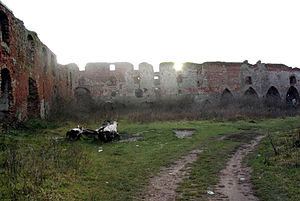Brandenburg Order Castle
| Brandenburg Order Castle | ||
|---|---|---|
|
Ruins of the Brandenburg Order Castle |
||
| Conservation status: | ruin | |
| Place: | Ushakowo (Kaliningrad, Gurjewsk, Novomoskowskoje) | |
| Geographical location | 54 ° 36 '50.2 " N , 20 ° 14' 55.6" E | |
|
|
||
The Brandenburg ( Russian За́мок Бранденбу́рг ) is a dilapidated order castle in today's Uschakowo in the former East Prussia , located directly on the Frischen Haff .
background
In 1206, Pope Innocent III published a bull about the Christianization of the Prussians , and in 1217 Pope Honorius III declared. a campaign against the Prussian pagans known as the Prussian Crusade, which the Teutonic Order joined in 1226. In 1230 the Pope granted the Teutonic Order the right to baptize the Prussians.
Foundation (1266)
According to the Chronicle of the State of Prussia by Peter von Dusburg , Margrave Otto III. from Brandenburg during the second Prussian uprising 1260–1283 to the Prussian land and founded the castle, which was named after him Brandenburg. The castle was built near the existing Lenzenburg.
"Anno domini MCCLXVI marchio Brandenburgensis, ut premissum est, cum multitudine pugnatorum venit ad terram Prussie, et cum aliud agere non posset, de consilio magistri et fratrum edificavit castrum Brandenburgk et a nomine marchionatus sui ad perpetuam memoriam sic voluit appellari"
There were several reasons for building the new castle. During the first Prussian uprising (1242-1249) it turned out that the neighboring Balga order castle , the previous main castle of the region, could be blocked too easily. Another reason was that the location of the new castle, located at the confluence of the Frisching into the lagoon, enabled the construction of a port and could serve as a connection between Balga and Königsberg instead of the Lenzenburg . The Brandenburg could thus serve as a starting point for the subjugation of the Prussians in the following years.
middle Ages
The Brandenburg Order Castle was the seat of one of the most important committees of the Order State. A settlement soon formed under the protection of the fortress, in which innkeepers, craftsmen, gardeners and fishermen lived.
In 1379 the Brandenburg Commander received a relic of St. Catherine from Emperor Charles IV , which was exhibited in the parish church.
In 1520 the castle was occupied and damaged by Polish troops. During the Thirteen Years' War , the castle was occupied and damaged by Bund troops in 1556.
Modern times
Demolition of the main house began in 1776. In 1820, the castle's granite pillars were still being used to restore the Marienburg .
During the Second World War, Brandenburg was in a zone of intense fighting and was partially destroyed.
After the Russian annexation of North East Prussia in 1945, the village was renamed Uschakowo. After a small renovation, several families of immigrants from the USSR lived in the south-eastern outbuilding of Vorburg. The southwestern Karwan, damaged in the war, was used as a shed. A small water tower was installed in the middle of the former outer courtyard. The rooms that were attached to the northern defensive wall before the war also served as barns.
In 1964, the All-Russian Art and Restoration Center recommended that the castle be listed as a historical monument, but it did not. In the early 1980s, part of the roof of the south-eastern outbuilding fell into disrepair. Since the beginning of the nineties, the remaining masonry has been removed for use as building material.
Modern
According to the decree of the Government of the Kaliningrad Region of March 23, 2007, No. 132, the ruin received the status of a cultural heritage of regional importance.
In 2013, the State Protection Service for Cultural Property of the Kaliningrad Region signed an agreement with the Moscow company ART Restoration on the restoration of the Order Castle.
As of 2016, the restoration project was frozen. In 2017, the Northwest Directorate of the Russian Ministry of Culture allocated 15 million rubles for the restoration of the castle. In the same year, the ruins were cleared of rubble and the restoration of the masonry walls of both wings of the castle began.
Description of the monument
The Brandenburg was the largest Komtursburg after Ragnit . The castle was a three-winged fort with a keep. A rich architectural sculpture Marienburh in Lochstädt was remarkable. The gate was in the middle of the west wing opposite the outer bailey. All four outbuildings had basements. The first floors of the castle buildings served as utility rooms. In the northeast outbuilding there was a kitchen, next to which was a well made of carved limestone, which was filled in in 1838. The remter was in the west wing, on the second floor.
literature
- Christofer Herrmann: Castles in Ordensland: A travel guide to the Teutonic Order and Bishop's castles in East and West Prussia. Freiburg 2006, ISBN 3-87057-271-X
- Ordensburg Brandenburg on ostpreussen.net
- 3D tour of the ruin
Individual evidence
- ↑ Scriptores rerum Prussicarum: the historical sources of the Prussian prehistoric times up to the fall of the order , volume 1
- ^ Scientific contributions to the history and regional studies of East Central Europe . Issue 106. Johann Gottfried Herder Institute, 1977.
- ↑ Постановление Правительства Калининградской области от 23 марта 2007 года № 132
- ↑ Three order castles near Kaliningrad are waiting to be restored. 06/19/2013



